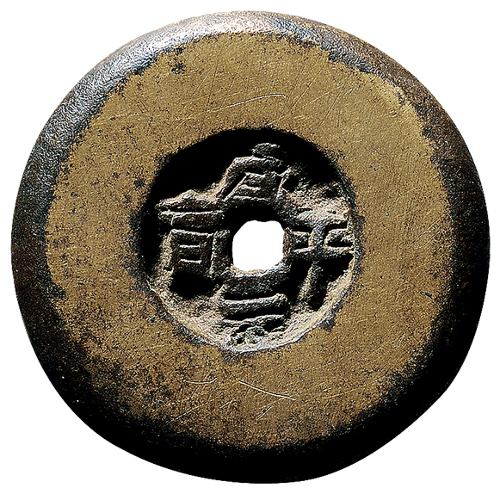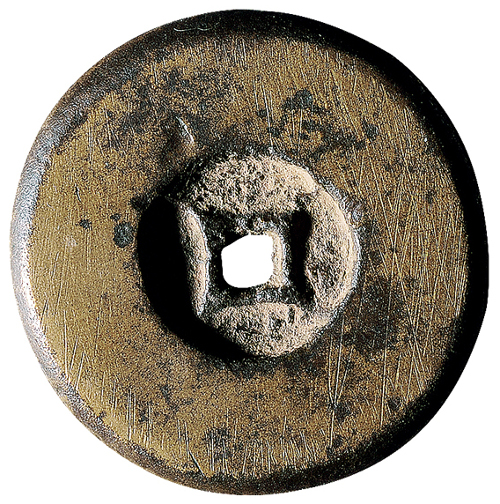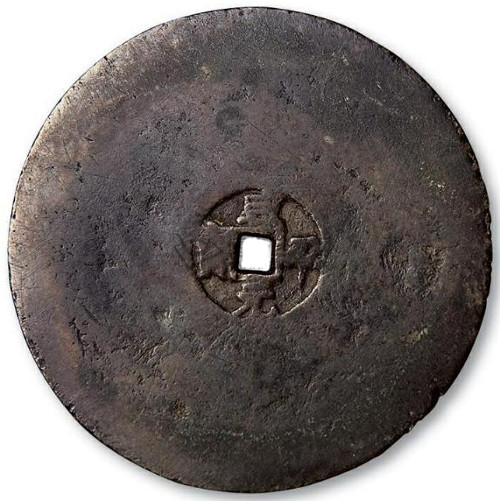During the reign (998-1022) of Emperor Zhenzong (真宗) of the Northern Song dynasty (北宋), a small quantity of cash coins were minted that had very broad rims and/or were very thick. Chinese coin collectors refer to these coins as bing qian (饼钱) which translates as “biscuit” coins or “cake” coins.
This was not the first time such biscuit money had been produced. Wang Mang (王莽) of the Xin dynasty (新朝) during his reign (7-23) also cast huo quan (货泉) coins that were very thick and heavy. However, this earlier cake money did not have the very broad rims that distinguish the Song dynasty biscuit coins.
Emperor Zhenzong of the Song issued regular cash coins under four different reign periods: xian ping (咸平 998-1003), jing de (景德 1004-1007), da zhong xiang fu (大中祥符 1008-1016) and tian xi (天禧 1017-1021).
However, only during the xian ping and xiang fu regnal periods were biscuit coins produced having the inscriptions xian ping yuan bao (咸平元宝) and xiang fu yuan bao (祥符元宝), respectively.
No authentic biscuit coins with the inscriptions jing de yuan bao (景德元宝) or tian xi tong bao (天禧通宝) are known to exist.

Large, broad-rimmed and thick “xian ping yuan bao” biscuit coin from the Song Dynasty
Shown above is an outstanding example of a xian ping yuan bao biscuit coin. The coin is large and heavy and has an extremely broad rim which slopes downward near the edge.
The reverse side, shown below, also has a very wide rim.
You will also notice that the corners of the square hole on the reverse side extend outwards towards the rim. This is known as si jue (四诀) and is only found on certain Song dynasty coins.

Reverse side of “xian ping yuan bao” biscuit coin displaying a broad rim and a square hole with the corners extending outwards
Common xian ping yuan bao cash coins have diameters of 2.14 – 2.6 mm and weigh 2.2 – 5.8 grams.
In contrast, this specimen has a diameter of 46.7 mm and weighs 73.2 grams.
The coin sold at auction in 2013 for US$2,623 (RMB 17,250).
The reason why these broad-rimmed and heavy coins were produced is still unknown.
Mr. Sun Zhonghui (孙仲汇), a well-known Chinese numismatist, wrote in 古錢幣圖解 (gu qian bi tu jie) that these coins were definitely cast during the Song dynasty. The coins are not standardized and their size and weight varies. He states that further research is needed to determine what their value was at the time and whether or not they actually circulated as currency.
Mr. Sun further states that many of these coins have been found in Sichuan (四川). During the Song dynasty, the government expropriated copper items and copper (bronze) cash coins resulting in a copper shortage in the province. The coins that circulated were made of iron. Because of the copper shortage, the purchasing power of the iron coins fell drastically while that of the copper coins soared. Because large and heavy copper coins like these biscuit coins would have had real value, Mr. Sun feels the probability is very good that these coins circulated as currency.
Shown below is perhaps the most famous of the Song dynasty biscuit coins.

Very large “xian ping yuan bao” biscuit coin
This huge xian ping yuan bao biscuit coin was owned by Mr. Ma Dingxiang (马定祥) who was regarded as one of the most respected Chinese numismatists of the 20th Century. (For some other famous coins owned by Mr. Ma Dingxiang, please see The King of Qing Dynasty Coins, State of Qin Silver Banliang Coin, and Vault Protector Coins.)
The coin has a diameter measuring 66 mm but, unfortunately, the weight is not specified. Nevertheless, it is the largest Song dynasty biscuit coin known to exist and the only specimen of its kind.
This coin was listed at an auction in 2008 with an estimated price of $9,124 – $15,207 (RMB 60,000 – 100,000).
Other representative examples of xian ping yuan bao biscuit coins are listed below:
- 26.5 mm/10.68 gram specimen may be seen here
- 26.5 mm specimen auctioned here
- 28.4 mm specimen shown here
- 30.1 mm/2.5 mm thick specimen seen here
- 32.5 mm specimen auctioned here
- 34.0 mm specimen from the collection of Mr. Sun Zhonghui (孙仲汇) shown here
- 44.0 mm/6 mm thick/72.0 gram specimen with si chu (四出) auctioned here
Regarding Song dynasty biscuit coins, there are far fewer xiang fu yuan bao (祥符元宝) known to exist than xian ping yuan bao. An example of a xiang fu yuan bao biscuit coin with a diameter of 26.4 mm was listed at this auction in Shanghai in 2014.